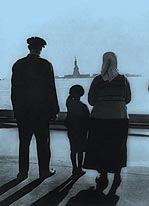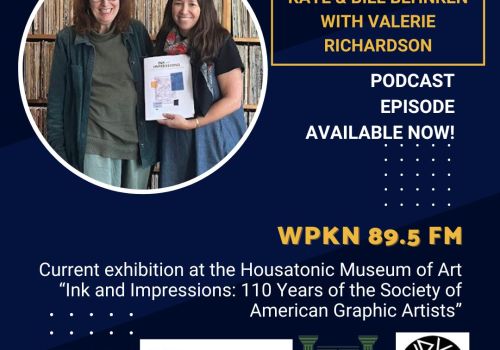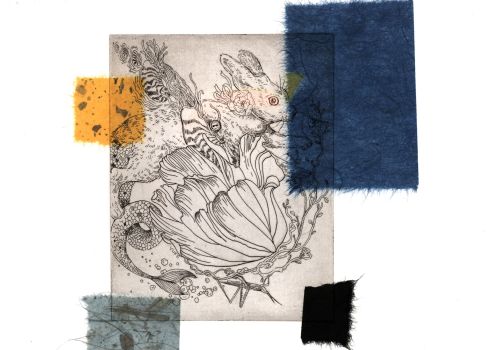SUGGESTED HIGHLIGHTS
– FREEDOM TOUR
Tours are interactive;
students who are currently studying American history are asked
to contribute what they know about the periods or events depicted.
Students are asked to comment on what they see, think and
feel about the reproductions of visuals and documents.
The tour begins
with the colonial period and ends with the twentieth century,
but most of the panels are on the 19th century and the Civil
War.
Trained guides
will start with a basic review of the founding principles
of freedom. They will choose from 8-12 of the following highlights,
according to the suggestions of the teachers and the interest
of the students.
 Painting
by Paul Revere – The Bloody Massacre, 1770 Painting
by Paul Revere – The Bloody Massacre, 1770
A snowball fight
began this killing of colonists.
Student Question: What do you know about Paul Revere?
 The
Declaration of Independence – a “revolutionary”
document The
Declaration of Independence – a “revolutionary”
document
“We hold
these truths to be self-evident; that all men are created
equal; that they are endowed by their Creator with certain
unalienable Rights; that among these are life,
liberty and the pursuit of happiness; that to secure
these rights, governments are instituted among men, deriving
their just powers from the consent of the governed.”
Student Question:
What do you think of the above underlined phrases?
All
“men” are created equal (who does this exclude?)
The “rights” to “liberty”
and “consent of the governed.”
 Power
Derived from the Consent of the Governed Power
Derived from the Consent of the Governed
The Declaration
of Independence determines that the government is set up
by the people, to represent the people, and to serve the
people. People have the power to dissolve the government:
“…whenever
any Form of government becomes destructive of these Ends,
it is the Right of the People to alter or abolish it and
to institute new Government, laying its Foundation on such
Principles.”
After a “train
of abuses” or a “Design to reduce them under absolute
Despotism, it is their Right, it is their Duty, to throw
off such Government.”
The colonists
threw off the rule of Britain under the King George III.
The tension between the people and government has existed
throughout history and all over the world.
THE CONSTITUTION
OF THE UNITED STATES
 Right
of Impeachment Right
of Impeachment
“The
President, Vice President and all civil officers of the
U.S. shall be removed from office on impeachment for, and
conviction of, treason, bribery, or other high crimes and
misdemeanors.”
In the Constitution
“impeachment” appears six times. The Founders
had lived under King George III and had accused him of usurping
the power of the people, being above the law and criminal
abuse of authority.
After the Civil
War, during Reconstruction, The House of Representatives
impeached President Johnson for things like encouraging
racial bigotry and slowing the process of achieving “justice
for all.” But because he did not commit “high
crimes”, therefor he was acquitted in the Senate trial.
A similar thing
happened to President Bill Clinton. He was impeached by the
House in 1998 for lying under oath about sexual misconduct,
but acquitted by the Senate for the same reason: it was not
proven he had committed high crimes.
President Richard Nixon resigned in the 1970’s because
he faced almost certain impeachment by the House and a probable
conviction in the Senate. 56 men in his administration were
convicted of crimes and some went to jail. Twenty large corporations
were found guilty of making illegal contributions. The House
began to prepare the articles of impeachment following the
guidelines of our Constitution: obstruction of justice regarding
the Watergate break-in, violating the constitutional rights
of citizens by authorizing illegal wiretaps.
Today former U.S. Attorney General Ramsey Clark has drafted
articles of impeachment against President Bush, V.P. Richard
Cheney, Secretary of Defense Rumsfeld and Attorney General
John D. Ashcroft. Some of the charges are: “deprivations
of the civil rights of the people of the United States and
other nations, assuming powers of an imperial executive unaccountable
to law and usurping power of Congress, the Judiciary and those
reserved to the people of the U.S.”
Student Question::
When do you think it’s justified to exercise our constitutional
right to remove our leaders from office?
 First
draft of U.S. Constitution First
draft of U.S. Constitution
The compromise
on freedom: In order to get Southern states to ratify the
constitution, a clause was added by Pierce Butler, one of
the wealthiest slaveholders from S. C. It required the return
of slave fugitives to their owners.
Student Question:
Is compromise necessary sometimes?
 The
Bill of Rights The
Bill of Rights
Amendments to
the Constitution adopted in 1791.
Student Question::
What freedoms to we have from our Bill of Rights? (freedom
of religion, speech, press, to assemble, petition the government)
Listen to this
description and try to figure out what period it is describing:
War
is imminent. Foreigners are feared. Laws are passed to restrict
the civil liberties of non-citizens and citizens as well.
Though
this may sound like present-day U.S. since September 11, 2001,
it is actually a description of the U.S. just seven years
after the Constitutional amendments called the Bill of Rights
were adopted (paraphrased from Joy Hakim’s book). The
Sedition Act of 1798 signed into law by President Adams made
it a crime to criticize the government. Today most historians
believe these were bad laws.
 Habeas
Corpus Habeas
Corpus
Our U.S. Constitution
addresses the abuse of being held in prison without being
charged. That is called “habeas corpus.”
Section 9 of
Article I states:
“The
privilege of the writ of habeas corpus shall not be suspended,
unless when in cases of rebellion or invasion the public
safety may require it.”
Today Attorney
General Ashcroft tells us our security requires that we
suspend habeas corpus, and our government is holding suspected
terrorists and hundreds of prisoners at our base in Guantanamo
Bay without formally charging them with a crime. In Congress,
some conservatives and liberals are joining to question
these laws.
Student Question:
Is the Patriot Act passed in October 2001, and the newly
Patriot II Act currently being drafted by Attorney General
Ashcroft a necessity to secure our liberties, or a threat
to our liberties?
 Visual:
“Slave Market of America.” Visual:
“Slave Market of America.”
Abolitionist
broadside of the 1830’s that exposed the brutality
of slavery, calling it a violation of the Bible, the Declaration,
and the Constitution.
Students:
Describe what do you see
 Visual:
Map of U.S. after the Missouri Compromise with territories
added as of 1820. By John Melish Visual:
Map of U.S. after the Missouri Compromise with territories
added as of 1820. By John Melish
Student
Question: What do you know about the expansion of the
U.S. territories? What were the issues?
 Advertisement
for John Warner Barber’s A History of the Amistad Captives,
New Haven, CT 1840. Advertisement
for John Warner Barber’s A History of the Amistad Captives,
New Haven, CT 1840.
Student
Question: Who knows the story of the Amistad?
 Louis
Adolph Gautier engraving of Stump speaking”, a painting
by George C. Bingham. NY 1856. Louis
Adolph Gautier engraving of Stump speaking”, a painting
by George C. Bingham. NY 1856.
Student
Question: How important is it to be politically aware
and to vote?
 Abraham
Lincoln, manuscript fragment of “House Divided”
speech, ca. 1857. Draft for his acceptance speech as U.S.
Senator. Abraham
Lincoln, manuscript fragment of “House Divided”
speech, ca. 1857. Draft for his acceptance speech as U.S.
Senator.
“A house
divided against itself cannot stand. I believe this government
cannot endure permanently half slave, and half free.”
Student Question:
Why are these words so famous?
 Abolitionist
Flag of U.S. 1858. 10 X 5 feet. Discovered in 1996 and displayed
here for the first time. Abolitionist
Flag of U.S. 1858. 10 X 5 feet. Discovered in 1996 and displayed
here for the first time.
Student
Question: Count the number of stripes and stars? Why so
few?
 Union
Camp Life: Sketchbook of watercolors by Henry Berckhoff, 1861-63. Union
Camp Life: Sketchbook of watercolors by Henry Berckhoff, 1861-63.
Student
Question: What do you see? What does this tell us about
the life of an ordinary soldier (who was also a skilled artist)?
 Henry
C. Parrott, letter to his sister, Oct. 1862 Henry
C. Parrott, letter to his sister, Oct. 1862
“We
were pretty well cut to pieces...”
 The
Dead at Gettysburg: Photographs The
Dead at Gettysburg: Photographs
Student
Question: Do you think the realities of fighting in a
war are different from the promises of recruiters, and the
glamour of uniforms and medals?
 “Men
of Color, to Arms!” 1863 “Men
of Color, to Arms!” 1863
Frederick
Douglass lobbied Lincoln to organize black regiments.
 Photograph
of anonymous private, 1863 Photograph
of anonymous private, 1863
Student
Question:Do you think white Americans respected the African
American more, as Frederick Douglas predicted they would,
once he “had an eagle on his button, a musket on his
shoulder, and the star spangled banner over his head?”
 Emancipation
Proclamation,” engraving 1864 Emancipation
Proclamation,” engraving 1864
Student
Question: What did this mean for our nation?
 Fifteenth
Amendment Celebrated 1870 Fifteenth
Amendment Celebrated 1870
Student
Question: What hopes did African Americans have?
 Susan
B. Anthony Susan
B. Anthony
She voted illegally,
was convicted and jailed.
Student Question:
Did Susan B. Anthony have a lot of courage? Are there any
things that you would have the courage to speak up about?
 The
Rev. Dr. Martin Luther King, Jr. The
Rev. Dr. Martin Luther King, Jr.
Student
Question: What do you know about him and how he advanced
the cause of freedom?
TOUR FOLLOW-UP
Use it or Lose
it
We all know what
happens to our muscles when we don’t exercise. We lose
our strength. Use it or lose it. The same thing happens to
our mind. Use it or lose it. We, as citizens of a democracy,
need to exercise the freedoms of speech, press and assembly
granted us in our remarkable document, The Constitution of
the United States. The same principle applies: Use it or lose
it.
We encourage you
to use the exhibit information and questions for follow-up
research projects, discussions and debates on the important
issues brought up by the book, videos and exhibit, Freedom:
A History of US.
Educational Materials
Prepared by Janet Luongo, Educational Consultant
|





